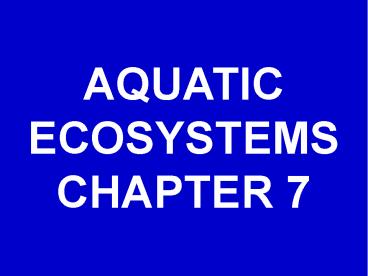estuary - PowerPoint PPT Presentation
Title:
estuary
Description:
AQUATIC ECOSYSTEMS CHAPTER 7 ocean freshwater saltwater plankton nekton benthos upwelling swamps wetland littoral zone benthic zone estuary lake algal bloom – PowerPoint PPT presentation
Number of Views:121
Avg rating:3.0/5.0
Title: estuary
1
AQUATIC ECOSYSTEMS CHAPTER 7
freshwater
ocean
saltwater
plankton
nekton
benthos
upwelling
swamps
wetland
littoral zone
benthic zone
estuary
lake
algal bloom
river
salt marsh
B a r r i e r I s l a n d
eutrophication
coral reef
salinity
2
Freshwater Ecosystems
3
...determine where Org livesin the water.
- Temp
- Sunlight
- O2
- Nutrients
4
TYPES of ORGS
- Plankton (phyto - zoo -)
- Float near surface
- Principal food source in aquatic ecosystems
- Nekton
- Free-swimming orgs fish, turtles, whales...
- Benthos
- Bottom-dwellers mussels, worms, barnacles...
5
TYPES of FW Ecosystems
- Lakes
- Ponds
- Wetlands
- Rivers
- Streams
6
LIFE in a LAKE...
- LITTORAL ZONE
- Near shore
- Nutrient-rich
- Abundant/diverse life due to sunlight
(photosynthesis)
- BENTHIC ZONE
- Lake bottom no light for photosynthesis
- Dead decaying orgs
- Decomposers, insect larvae, clams...carp.
...depends on the amount of sunlight available!
7
Eutrophication
- Increase in amount of nutrients in aquatic
ecosystem. - Nutrients cause plants algae to increase...
- Bacteria increase as dead plant matter
grows...bacteria use up dissolved O2... - O2 - loving organisms die off.
- Lakes naturally become eutrophic over time....
8
...but the process can be accelerated by sewer
system or agricultural runoff that places
fertilizer (and I use the term loosely!) into
lakes ponds.
9
FW WETLANDS
- Areas of land periodically covered with water.
- MARSHES contain non-woody plants (cattails,
reeds, rushes) - SWAMPS woody plants (trees, shrubs)
10
Marshes
- Characterized by low, flat land...little water
movement...some brackish, some saltier. - Flat-billed fowl (ducks, grebes) adapted for
skimming insects off surface those with
spear-like beaks (herons) suited to grasping
small fish digging for buried frogs. - Florida Everglades largest freshwater wetland in
U.S.
11
Swamps
- Flat, poorly drained land woody shrubs or
water-loving trees. - Snakes...bullfrogs...alligators!
12
Freshwater WETLANDS provide important
environmental functions
- Act as filters or sponges to absorb remove
pollutants from groundwater improve water
quality of lakes/reservoirs downstream. - Control flooding by absorbing extra water from
rivers hurricane storm surges...saving
urban/residential areas from damage. - Habitat for migratory waterfowl...spawning
grounds for game fish...cranberries! - Buffer zones to protect against shoreline
erosion.
13
...they used to be wastelands...
- For decades, it was believed they were just
breeding grounds for mosquitoes... - Millions of acres were recovered via drainage,
filling in, clearing... - Now (thanks to envi sci!) they are protected by
government...their destruction is prohibited.
14
Rivers
- Rivers have been long used as free water sources
for industry (and dumping grounds...) - Toxins have killed off much river life and made
river fish inedible...city farm runoff put
pesticides other poisons in rivers. - Dams alter ecosystems in and around rivers.
15
Marine Ecosystems
16
Estuaries
- Freshwater source (river) mixes with saltwater
source (ocean). - Currents cause nutrient trap to form _at_ bottom.
Sunlight penetrates shallow waters. - Rich nutrients/photosynthesis make estuaries some
of the most biologically productive ecosystems on
the planet. - Protected from waves by peninsula/barrier
islands.
17
Estuary Life
- Plants plankton fish dolphins, manatees,
seals et al...abundant food web. - Oysters, barnacles, clams (filter feeders)
- Orgs are able to tolerate varying salinity
- Humans love estuaries too...
18
Threats to Estuaries
- Of the 10 largest urban areas on the planet, 6
are built on estuaries - Tokyo
- New York City
- Shanghai
- Buenos Aires
- Rio de Janeiro
- Bombay
19
Threats to Estuaries
- California estuaries filled in with waste used
as building sites. - Rivers carry pollutants downstream to estuary
(sewage, ag waste, pesticides, toxic chemicals)
20
(No Transcript)
21
(No Transcript)
22
(No Transcript)
23
(No Transcript)
24
(No Transcript)
25
(No Transcript)
26
Chesapeake Bay
27
Barrier Islands
- Formed by rising sea levels (over the past 15,000
years) - Long, narrow sand ridges parallel to coastline, 3
to 30 km out. - Protect mainland coastal wetlands from storms
waves. - ...dont spend a lot of buying a home on em...
28
(No Transcript)
29
(No Transcript)
30
Sanibel Island
31
(No Transcript)
32
Southern Rhode Island
33
Coral Reefs
- Limestone ridges built by photosynthetic algae
skeletons of coral polyps. - Found only in clear, warm, shallow saltwater.
- Among the most diverse ecosystems on planet
(thousands of species). - Convoluted shape provides habitats for fish,
snails, clams, sponges...
34
Coral Reefs
- 27 of worlds coral reefs in danger...
- Oil spills...sewage...pesticides...silt
runoff...overfishing... - If water gets too warm/too cold...
- If fresh water drains onto reef...
- If water gets too muddy/polluted...
- Reefs are fragile, they grow too slowly to repair
themselves in time...
35
Great Barrier Reef
36
(No Transcript)
37
(No Transcript)
38
(No Transcript)
39
Oceans
- Usable sunlight penetrates to only 100 m
depth... - ...most ocean life thus located in shallow
coastal areas, not in open oceans. - Seaweed, algae, plankton...inverts fish that
feed on them are concentrated near-shore. - Many different minisystems exist...
- Open oceans are possibly the least productive of
all ecosystems.
40
UPWELLING
- _at_ coastlines surface currents carry water away
from shore... - Deeper, nutrient rich bottom water wells upto
fill in... - Phytoplankton love it...fish come for
phytoplankton...humans come for fish...its all
good?
41
(No Transcript)
42
Threats to Oceans
- Fertilizer runoff from shore causes algal
bloom...some are poisonous! - Industrial waste sewage coastal pollution.
- Overfishing is destroying some fish
populations... - Stupid fishing methods are murdering innocent
creatures...































